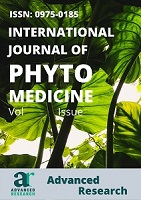Achillea millefolium Linn. A Comprehensive Review of its Unani Description, Therapeutic Potential and Phytochemical Diver
Keywords:
Biranjasif, Achillea millefolium, unani, yarrow, AsteraceaeAbstract
Commonly referred to as yarrow, Achillea millefolium Linn. is an upright perennial plant in the Asteraceae family. It is widely found in temperate regions and has long been used for its therapeutic qualities, especially in Chinese, Native American, European, and Greek traditional medicine. The pharmacological properties of yarrow are well known and include anti-inflammatory, antibacterial, antioxidant, lithotriptic, carminative, and hemostatic actions. The plant's aerial parts are very useful for treating phlegm-related conditions, stimulating the generation of bile, and functioning as a diuretic and bitter digestive tonic. Its abundance of bioactive substances, including flavonoids, terpenes, alkaloids, and essential oils, is largely responsible for these qualities. In order to lay the groundwork for future study directions, this paper attempts to thoroughly examine the morphology, phytochemistry, and pharmacological characteristics of yarrow.
References
Benedek B, Kopp B, Melzig MF. Achillea millefolium L. sl–Is the anti-inflammatory activity mediated by protease inhibition? J Ethnopharmacol. 2007 Sep 5;113(2):312-7.
Leroi GA. The flowers found with Shanidar: A Neanderthal burial in Iraq. Science. 1975;190:562-4.
Solecki RS. Shanidar IV, a Neanderthal flower burial in northern Iraq. Science. 1975;190:880-1.
Osbaldeston TA, Wood RPA. Dioscorides: De Materia Medica. Johannesburg: Ibidis Press; 2000.
Bremer K. Asteraceae: Cladistics and Classification. Portland, Oregon: Timber Press; 1994.
Trease GE, Evans WC. Pharmacognosy. 4th ed. London: Bailliere Tindall; 1972. p. 283.
Radusiene J, Gudaityte O. Distribution of proazulenes in Achillea millefolium wild populations in relation to phytosociological dependence and morphological characters. Plant Genet Resour. 2005;3:136-43.
Usmanghani K, Saeed A, Tanweer A. Traditional uses of A. millefolium. Indus Med. 1997;1:93-5.
Kritikar KR, Basu BD. Indian Medicinal Plants. Vol. II. Allahabad: Lalit Mohan Publication; 2012. p. 1375-8.
Karamenderes C, Apaydin S. Antispasmodic effect of Achillea nobilis L. subsp. sipylea (O. Schwarz) Bassler on the rat isolated duodenum. J Ethnopharmacol. 2003;84:175-9.
Stojanovic G, Radulovic N, Hashimoto T, Palic R. In vitro antimicrobial activity of extracts of four Achillea species: the composition of Achillea clavennae L. (Asteraceae) extract. J Ethnopharmacol. 2005;101:185-90.
Cavalcanti AM, Baggia CH, Freita CF, et al. Safety and anti-ulcer efficacy study of Achillea millefolium L. after chronic treatment in Wistar rats. J Ethnopharmacol. 2006;107:277-84.
Tajik HO, Shokuhi Sabet Jalali F. In vitro assessment of antimicrobial efficacy of aqueous extract of garlic against wound-infecting microorganisms. J Med Plants. 2008;2(26):10-5.
Fierascu I, Ungureanu C, Avramescu SM, Fierascu RC, Ortan A, Soare LC, Paunescu A. In vitro antioxidant and antifungal properties of Achillea millefolium L. Rom Biotechnol Lett. 2015;20:10626-36.
Baser KH, Demirci B, Demirci F, et al. Composition and antimicrobial activity of the essential oil of Achillea millefolium. Planta Med. 2002;68:941-3.
Benedek B, Rothwangi WK, Rozema E, et al. Yarrow (Achillea millefolium): pharmaceutical quality of commercial samples. Pharmazie. 2008;63:23-6.
Anne O, Elmer A, Ain R. Phytochemical analysis of the essential oil of Achillea millefolium L. from various European countries. Nat Prod Res. 2006;20:1082-8.
Sastri BN. The Wealth of India: A Dictionary of Indian Raw Materials & Industrial Products. Vol. I: A. 2005.
Sina I. Al Qanoon Fit Tib. Vol. I. New Delhi: Aijaz Publication; 2010. p. 291.
Khan MA. Muheet Azam. Vol. I; 1896.
Baitar IAK. Al Jami Li Mufradat Al Advia wal Aghzia. Vol. I-IV (Urdu). New Delhi: CCRUM; 1999. p. 1-450, 1-370, 19-394, 121-213, 21-463.
Ghani Hkm N. Qarabadeen Najmul Ghani. New Delhi: Central Council of Unani Medicine; 2010. p. 52-4.
Ibn Rushd. Kitab Al-Kulliyat. (Urdu Translation by CCRUM). New Delhi: CCRUM Publication No. 27; 1987. p. 224-7, 256.
Akram M. Minireview on Achillea millefolium Linn. J Membr Biol. 2013;246:661-3.
Arzani MA. Qarabadeen Qadri. New Delhi: Aijaz Publishing House; 1998. p. 504-8.
Khan HA, Qarabadeen Azam, Ist edition. Aijaj Publication house, Darya gunj, New Delhi, 1994.
Khan HA, Qarabadeen Azam wa akmal, Central Council for Research in Unani Medicine, New Delhi, 2005
Ghani HN, Qarabadeen Najmul Ghani, Central Council for Research in Unani Medicine, New Delhi, 2010
Wojdyło A, Oszmiański J, Czemerys R. Antioxidant activity and phenolic compounds in selected herbs. Food Chem. 2007 Jan;105(3):940-9.
Keser S, Celik S, Turkoglu S, Yilmaz O, Turkoglu I. Antioxidant activity, total phenolic and flavonoid content of water and ethanol extracts from Achillea millefolium L. Turk J Pharm Sci. 2013;10:385-92.
Li Y, Zhang ML, Cong B, Wang SM, Dong M, Sauriol F, Huo CH, Shi QW, Gu YC, Kiyota H. Achillinin A, a cytotoxic guaianolide from the flower of Yarrow, Achillea millefolium. Biosci Biotechnol Biochem. 2011;75:1107062554.
Vitalini S, Beretta G, Iriti M, Orsenigo S, Basilico N, Dall'Acqua S, Iorizzi M, Fico G. Phenolic compounds from Achillea millefolium L. and their bioactivity. Acta Biochim Pol. 2011;58(2).
Innocenti G, Vegeto E, Dall’Acqua S, Ciana P, Giorgetti M, Agradi E, Sozzi A, Fico G, Tomè F. In vitro estrogenic activity of Achillea millefolium L. Phytomedicine. 2007;14(2-3):147-52.
Pires JM, Mendes FR, Negri G, Duarte‐Almeida JM, Carlini EA. Antinociceptive peripheral effect of Achillea millefolium L. and Artemisia vulgaris L.: both plants known popularly by brand names of analgesic drugs. Phytother Res. 2009;23(2):212-9.
Falk AJ, Smolenski SJ, Bauer L, Bell CL. Isolation and identification of three new flavones from Achillea millefolium L. J Pharm Sci. 1975 Nov;64(11):1838-42.
Greger H. Flavonoide und Systematik der Anthemideae. Naturwissenschaften. 1969;56:467-8.
Csupor-Löffler B, Hajdú Z, Zupkó I, Réthy B, Falkay G, Forgo P, Hohmann J. Antiproliferative effect of flavonoids and sesquiterpenoids from Achillea millefolium sl on cultured human tumour cell lines. Phytother Res. 2009;23(5):672-6.
Yassa N, Saeidinia S, Akbarpour M, Piroozi R, Shafiei A. Three phenolic glycosides and immunological properties of Achillea millefolium from Iran, population of Golestan.
Borrelli F, Romano B, Fasolino I, Tagliatatela-Scafati O, Aprea G, Capasso R, Capasso F, Coppola Bottazzi E, Izzo AA. Prokinetic effect of a standardized yarrow (Achillea millefolium) extract and its constituent choline: studies in the mouse and human stomach. Neurogastroenterol Motil. 2012;24:164-e90.
Chandler RF, Hooper SN, Hooper DL, Jamieson WD, Flinn CG, Safe LM. Herbal remedies of the Maritime Indians: sterols and triterpenes of Achillea millefolium L. (Yarrow). J Pharm Sci. 1982;71:690-3.
Tozyo T, Yoshimura Y, Sakurai K, Uchida N, Takeda Y, Nakai H, Ishii H. Novel antitumor sesquiterpenoids in Achillea millefolium. Chem Pharm Bull. 1994;42(5):1096-100.
Rucker G, Kiefer A, Breuer J. Isoachifolidiene, a precursor of guaianolide peroxides from Achillea millefolium. Planta Med. 1992;58(3):293-5.
Farooq U, Khan A, Khan SS, Iqbal S, Sarwar R, Khan SB, Ahmad VU. Isolation and structure determination of three new sesquiterpenoids from Achillea millefolium. Z Naturforsch B. 2012;67(5):421-5.
Konovalov DA, Chelombit'ko VA. Sesquiterpene lactones from Achillea millefolium. Chem Nat Compd. 1991;27(5):640-1.
Ulubelen A, Öksüz S, Schuster A. A sesquiterpene lactone from Achillea millefolium subsp. millefolium. Phytochemistry. 1990;29(12):3948-9.
Verzár-Petri G, Tamás J, Radics L, Ujszászi K. Separation and identification of prochamazulenes of Achillea millefolium L. ssp. collina Becker. In: II International Symposium on Spices and Medicinal Plants; 1979. p. 105-12.
Falconieri D, Piras A, Porcedda S, Marongiu B, Gonçalves MJ, Cabral C, Cavaleiro C, Salgueiro L. Chemical composition and biological activity of the volatile extracts of Achillea millefolium. Nat Prod Commun. 2011;6(10):1934578X1100601030.
Sevindik E, Abacı ZT, Yamaner C, Ayvaz M. Determination of the chemical composition and antimicrobial activity of the essential oils of Teucrium polium and Achillea millefolium grown under North Anatolian ecological conditions. Biotechnol Biotechnol Equip. 2016;30(2):375-80.
Costescu CI, Rădoi BP, Hădărugă NG, Gruia AT, Riviș A, Pârvu D, David I, Hădărugă DI. Obtaining and characterization of Achillea millefolium L. extracts. J Agroaliment Processes Technol. 2014;20(2):142-9.
Rahimmalek M, Tabatabaei BE, Etemadi N, Goli SA, Arzani A, Zeinali H. Essential oil variation among and within six Achillea species transferred from different ecological regions in Iran to field conditions. Ind Crops Prod. 2009;29(2-3):348-55.
Jaimand K, Rezaee MB, Mozaffarian V. Chemical constituents of the leaf and flower oils from Achillea millefolium ssp. elbursensis Hub.-Mor. from Iran rich in chamazulene. J Essent Oil Res. 2006;18(3):293-5.
Lourenco PM, Figueiredo AC, Barroso JG, Pedro LG, Oliveira MM, Deans SG, Scheffer JJ. Essential oils from hairy root cultures and from plant roots of Achillea millefolium. Phytochemistry. 1999;51(5):637-42.
Anne O, Tiiu K, Kaire L. Composition of the essential oil from Achillea millefolium L. from Estonia. J Essent Oil Res. 2001;13:290-4.
Candan F, Unlu M, Tepe B, Daferera D, Polissiou M, Sökmen A, Akpulat HA. Antioxidant and antimicrobial activity of the essential oil and methanol extracts of Achillea millefolium subsp. millefolium Afan. J Ethnopharmacol. 2003 Aug 1;87(2-3):215-20.
Zeinivand J, Yousefzadeh N. Essential oil composition of Achillea millefolium growing in Darrehshahr township. Iran Chem Commun. 2013;1:25-34.
Judzentiene A. Atypical chemical profiles of wild yarrow (Achillea millefolium L.) essential oils. Records Nat Prod. 2016;10(2):262.
Judzentiene A, Mockute D. Essential oil composition of two yarrow taxonomic forms. Open Life Sci. 2010;5(3):346-52.
Kazemi M. Phytochemical and antioxidant properties of Achillea millefolium from the eastern region of Iran. Int J Food Prop. 2015;18(10):2187-92.
Mazandarani M, Mirdeilami SZ, Pessarakli M. Essential oil composition and antibacterial activity of Achillea millefolium L. from different regions in Northeast Iran. J Med Plants Res. 2013;7(16):1063-9.
Fraisse, Didier & Felgines, Catherine & Texier, Odile & Lamaison, Jean-Louis. Caffeoyl Derivatives: Major Antioxidant Compounds of Some Wild Herbs of the Asteraceae Family. Food and Nutrition Sciences. 2011. 2. 10.4236/fns.2011.230025.
Nadim MM, Malik AA, Ahmad J, Bakshi SK. The essential oil composition of Achillea millefolium L. cultivated under tropical conditions in India. World J Agric Sci. 2011;7(5):561-5.
Ebadollahi A, Ashouri S. Toxicity of essential oils isolated from Achillea millefolium L., Artemisia dracunculus L. and Heracleum persicum Desf. against adults of Plodia interpunctella (Hübner)(Lepidoptera: Pyralidae) in Islamic Republic of Iran. Ecol Balkanica. 2011;3(2).
De Souza P, Gasparotto A Jr, Crestani S, et al. Hypotensive mechanism of the extracts and artemetin isolated from Achillea millefolium L. (Asteraceae) in rats. Phytomedicine. 2011;18:819-25.
Nematy, M., Mazidi, M., Jafari, A., Baghban, S., Rakhshandeh, H., Norouzy, A., Esmaily, H., Etemad, L., Patterson, M., & Mohammadpour, A. H. The effect of hydro-alcoholic extract of Achillea millefolium on appetite hormone in rats. Avicenna journal of phytomedicine. 7(1), 10–15.
Benedek B, Geisz N, Jager W, Thalhammer T, Kopp B. Choleretic effects of Yarrow (Achillea millefolium) in the isolated perfused rat liver. Phytomedicine. 2006;13:702-6.
Khanday S , Kalam MA , Ahmad A, Yousuf A, Salim S & Dar Y. Evaluation of in-vitro activity of aerial part of baranjasif (Achillea millefolium Linn.) extracts. Indian Journal of Unani Medicine. 2021; 14. 10.53390/ijum.v14i1.8.
Baretta IP, Felizardo RA, Bimbato VF, et al. Anxiolytic-like effects of acute and chronic treatment with Achillea millefolium L. extract. J Ethnopharmacol. 2012;140:46-54.
Tariq KA, Chisshti MZ, Ahmad F, Shawl AS. Anthelmintic efficacy of Achillea millefolium against gastrointestinal nematodes of sheep: in vitro and in vivo studies. Hum Exp Toxicol. 2008;30:328-34.
Moradi MT, Rafieian-Koupaei M, Imani-Rastabi R, et al. Antispasmodic effects of yarrow (Achillea millefolium L.) extract in the isolated ileum of rats. Afr J Tradit Complement Altern Med. 2013;10:499-503.
Niazmand S, Saberi Z. The chronotropic and inotropic effects of aqueous-ethanolic extract of Achillea millefolium on rat’s isolated heart. Pharmacologyonline. 2010;791-8.
al-Kulya H. Evaluation of in vitro activity of aerial part of Biranjasif(Achillea millefolium Linn.) extracts. Indian J Unani Med. 2021 Jan;14(1):46-55.
Ghani N. KhazainulAdvia.New Delhi: IdaraKitab us Shifa; 2002.
Published
How to Cite
Issue
Section
License
Copyright (c) 2025 Suheena Khanday, Ghazala Javed, Mohd. Afsahul Kalam, Aamir Yousuf, Iqra Rifat

This work is licensed under a Creative Commons Attribution-NonCommercial-NoDerivatives 4.0 International License.


